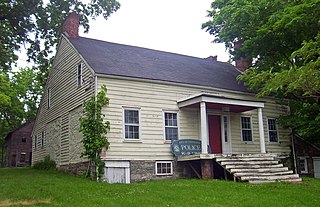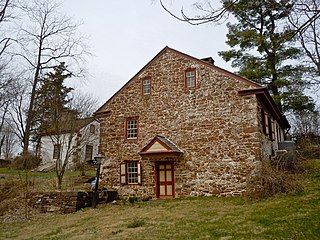
Warwick is a town in the southwestern part of Orange County, New York, United States. Its population was 32,027 at the 2020 census. The town contains three villages and eight hamlets.

John Hathorn was an American politician and Continental Army officer from New York.

Kykuit, known also as the John D. Rockefeller Estate, is a 40-room historic house museum in Pocantico Hills, a hamlet in the town of Mount Pleasant, New York 25 miles north of New York City. The house was built for oil tycoon and Rockefeller family patriarch John D. Rockefeller. Conceived largely by his son, John D. Rockefeller Jr., and enriched by the art collection of the third-generation scion, Governor of New York, and Vice President of the United States, Nelson Rockefeller, it was home to four generations of the family. The house is a National Historic Landmark owned by the National Trust for Historic Preservation, and tours are given by Historic Hudson Valley.

The John Blake House is located on Homestead Avenue in Maybrook, New York, United States. It is a brick building from the late 18th century, one of the oldest houses in the village

The Oliver Brewster House is a Gothic Revival home located on Willow Avenue in Cornwall, New York, United States, right across from Willow Avenue Elementary School. It was originally built as a farmhouse in the mid-19th century. Later, as Cornwall became a popular summer resort for visitors from New York City, it was expanded and renovated for use as a boardinghouse as well.

Montgomery Place, now Bard College: The Montgomery Place Campus, near Barrytown, New York, United States, is an early 19th-century estate that has been designated a National Historic Landmark. It is also a contributing property to the Hudson River Historic District, itself a National Historic Landmark. It is a Federal-style house, with expansion designed by architect Alexander Jackson Davis. It reflects the tastes of a younger, post-Revolutionary generation of wealthy landowners in the Livingston family who were beginning to be influenced by French trends in home design, moving beyond the strictly English models exemplified by Clermont Manor a short distance up the Hudson River. It is the only Hudson Valley estate house from this era that survives intact, and Davis's only surviving neoclassical country house.

The Hudson River Historic District, also known as Hudson River Heritage Historic District, is the largest Federally designated district on the mainland of the contiguous United States. It covers an area of 22,205 acres extending inland roughly a mile (1.6 km) from the east bank of the Hudson River between Staatsburg and Germantown in Dutchess and Columbia counties in the U.S. state of New York. This area includes the riverfront sections of the towns of Clermont, Red Hook, Rhinebeck and part of Hyde Park. This strip includes in their entirety the hamlets of Annandale, Barrytown, Rhinecliff and the village of Tivoli. Bard College and two protected areas, Margaret Lewis Norrie State Park and Tivoli Bays Unique Area, are also within the district.

The Locusts, also known as the Peter Eltinge House, is a 19th-century brick Federal style house built in 1826 located on Plains Road in the Town of New Paltz, New York, United States, two miles (3 km) south of the village of New Paltz. It was once the center of a large farm. The house and several outbuildings have been listed on the National Register of Historic Places as well-preserved examples of that style in Ulster County.

The Warwick Village Historic District is located in the center of the village of Warwick in the U.S. state of New York. It takes up an irregularly-shaped 130 acres of residential and commercial neighborhoods centered on NY 94 and 17A).

Woodlawn Farm, sometimes known as the Wood Homestead, is located on Mount Orange Road, a short distance north of Slate Hill, New York, United States. It is centered by a three-section farmhouse whose materials date to the mid-18th century, making it one of the oldest buildings in the Town of Wawayanda. In 2008 it was listed on the National Register of Historic Places.

The James "Squire" Patton House is located along the brief overlap of NY 207 and 300 in New Windsor, New York, United States. It is on a five-acre parcel owned by the nearby city of Newburgh, formerly used for police K-9 training. The house now sits abandoned and in a state of decay.

The Jeremiah Morehouse House is located on Hathorn Road in Warwick, New York, United States, just off NY 94. It is a wooden house that was listed on the National Register of Historic Places in 2006.

The Masten-Quinn House is located on First Street in the village of Wurtsboro, New York, United States. It is a wooden Greek Revival house built in two phases in the 1820s, the center of a farm that remained working until the mid-20th century. Today it is one of the few remainders from the area's agricultural past as a canal town.

The Newcomb–Brown Estate is located at the junction of the US 44 highway and Brown Road in Pleasant Valley, New York, United States. It is a brick structure built in the 18th century just before the Revolution and modified slightly by later owners but generally intact. Its basic Georgian style shows some influences of the early Dutch settlers of the region.

The Michael Salyer Stone House is located on Blue Hill Road in Orangetown, New York, United States. It was built in the late 18th century.

The George Rymph House is a historic house located on Albany Post Road in Hyde Park, New York, United States. It is a stone house built during the 1760s by a recent German immigrant. In 1993, it was listed on the National Register of Historic Places.

The Mordecai Lincoln House is a historic house in Exeter Township, Berks County, Pennsylvania built c. 1733 by Mordecai Lincoln, the great-great-grandfather of President Abraham Lincoln. The house stands in the narrow valley of Hiester Creek on a 9-acre plot near the village of Lorane on Lincoln Road.

Glengallan Homestead is a heritage-listed homestead on the New England Highway, Glengallan, Southern Downs Region, Queensland, Australia. It was built from 1864 to 1904. It is also known as Glengallan Head Station. It was added to the Queensland Heritage Register on 21 October 1992 and is open to the public.
Ohio Homestead is a heritage-listed farm and former boy's home located at Walcha in the Walcha Shire, in New South Wales, Australia. It was built from 1836 to 1839. The property is owned by Ohio Homestead Pty Ltd and it was added to the New South Wales State Heritage Register on 2 April 1999.
Windmill Hill is a heritage-listed former farm and now water catchment area located at Wilton Road in the outer south-western Sydney settlement of Appin in the Wollondilly Shire local government area of New South Wales, Australia. It was built from 1820 to 1950. It is also known as Windmill Hill Group, including Ruins, North Farm, Middle Farm aka Larkin Farm and Windmill Hill, South Farm and Steven's Homestead. The property is owned by Water NSW. It was added to the New South Wales State Heritage Register on 27 June 2014.




















